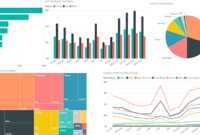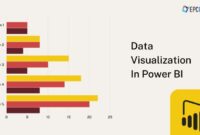BI reporting features set the stage for this enthralling narrative, offering readers a glimpse into a story that is rich in detail and brimming with originality from the outset. In this exploration, we delve into the world of BI reporting tools, uncovering their significance in modern data-driven decision-making processes.
Overview of BI Reporting Features

Business Intelligence (BI) reporting features refer to the capabilities within BI tools that allow users to analyze and visualize data to make informed decisions. These features help in transforming raw data into meaningful insights that can be easily understood and shared across an organization.
Popular BI Reporting Tools
- Tableau: Known for its powerful data visualization capabilities and user-friendly interface.
- Power BI: Offers robust reporting and dashboarding features, seamlessly integrated with Microsoft products.
- QlikView: Enables interactive data exploration and discovery through its associative data model.
- MicroStrategy: Provides enterprise-grade BI reporting solutions for large-scale analytics.
Importance of BI Reporting in Decision-Making
BI reporting plays a crucial role in decision-making processes by providing accurate and timely insights based on data analysis. It helps organizations identify trends, patterns, and outliers in data, leading to informed strategic decisions that drive business growth and efficiency.
Data Visualization with BI Reporting Features
Data visualization is a key aspect of BI reporting features as it enables users to represent complex data sets in a visually appealing format. By using charts, graphs, and dashboards, organizations can easily interpret data, identify trends, and communicate insights effectively to stakeholders.
Key Components of BI Reporting Features

BI reporting features consist of various essential elements that play a crucial role in providing valuable insights to businesses. Let’s delve into some key components:
Dashboards
Dashboards are a central component of BI reporting tools, offering a visual representation of key metrics and KPIs. They provide a quick overview of the business performance, allowing users to monitor trends, identify patterns, and make data-driven decisions efficiently.
Data Connectors
Data connectors are instrumental in BI reporting, enabling the integration of data from multiple sources into a single platform. These connectors facilitate the extraction, transformation, and loading of data, ensuring that users have access to up-to-date and consolidated information for analysis.
Filters and Drill-Down Capabilities, BI reporting features
Filters and drill-down capabilities enhance BI reporting by allowing users to refine data sets and focus on specific details. Filters enable users to narrow down the data based on specific criteria, while drill-down capabilities provide a deeper level of analysis by allowing users to explore data at a more granular level.
Customization Options in BI Reporting: BI Reporting Features

When it comes to BI reporting tools, customization options play a crucial role in tailoring reports to meet specific business needs. Let’s delve into the various customization features available in BI reporting tools and how they empower users to personalize their reports.
Template-Based vs. Custom Report Design
Template-based report design offers pre-defined structures and layouts that users can populate with data. While this provides a quick and easy way to create reports, it may limit flexibility in terms of design and visualization options. On the other hand, custom report design allows users to build reports from scratch, giving them complete control over the layout, formatting, and data visualization elements. This level of customization enables users to create reports that best suit their unique requirements and preferences.
Flexibility of Data Visualization Options
BI reporting tools offer a wide range of data visualization options, including charts, graphs, tables, and maps. Users can choose the most suitable visualization type based on the nature of their data and the insights they want to convey. Additionally, these tools often provide customization options within each visualization type, allowing users to adjust colors, labels, axes, and other visual elements to enhance the clarity and impact of their reports.
Personalization of BI Reports
Users can personalize BI reports in various ways, such as adding company logos, customizing headers and footers, applying filters and parameters, and selecting specific data fields to include. By personalizing reports, users can align them with their brand identity, highlight key metrics, and focus on the most relevant insights for their audience. This level of customization not only enhances the visual appeal of reports but also improves their effectiveness in conveying actionable information to stakeholders.
Advanced Functionality in BI Reporting
When it comes to Business Intelligence (BI) reporting, advanced functionality plays a crucial role in providing in-depth insights and analysis for decision-making. Let’s delve into the enhanced capabilities that come with advanced analytics, AI, machine learning, predictive analytics, and integration with big data and cloud computing.
Advanced Analytics Capabilities
Advanced analytics in BI reporting go beyond basic reporting and delve into complex data analysis techniques. These capabilities enable users to uncover hidden patterns, correlations, and trends in data that may not be apparent through traditional reporting methods. By leveraging advanced analytics, organizations can gain a competitive edge by making data-driven decisions based on deeper insights.
Role of AI and Machine Learning
AI and machine learning technologies are revolutionizing BI reporting by automating data analysis, identifying anomalies, and predicting future trends. These technologies enable BI reporting tools to learn from data patterns and make intelligent recommendations, ultimately enhancing decision-making processes and improving operational efficiencies.
Predictive Analytics and Forecasting Tools
Predictive analytics and forecasting tools empower organizations to anticipate future outcomes based on historical data and trends. By utilizing these tools within BI reporting, businesses can forecast sales, demand, and other key metrics, enabling them to proactively plan and strategize for the future.
Integration with Big Data and Cloud Computing
The integration of BI reporting with big data and cloud computing allows organizations to analyze vast amounts of data quickly and efficiently. By leveraging big data sources and cloud-based analytics platforms, businesses can scale their BI reporting capabilities, handle complex data sets, and derive valuable insights that drive business growth and innovation.
As we conclude this discussion on BI reporting features, it becomes evident that these tools play a pivotal role in transforming raw data into actionable insights. With advanced analytics, customization options, and integration capabilities, BI reporting features pave the way for informed decision-making and strategic planning in today’s data-centric landscape.
When it comes to analyzing data efficiently, having a reliable BI analytics platform is crucial. This tool helps businesses make informed decisions based on data-driven insights, leading to better overall performance.
Visualizing data is essential for understanding trends and patterns, and a powerful data visualization software can make this process seamless. With interactive charts and graphs, users can easily interpret complex data sets and communicate findings effectively.
Efficient reporting is key to monitoring business performance, and BI reporting tools play a vital role in this process. These tools help in creating customizable reports and dashboards, providing valuable insights for decision-makers.




